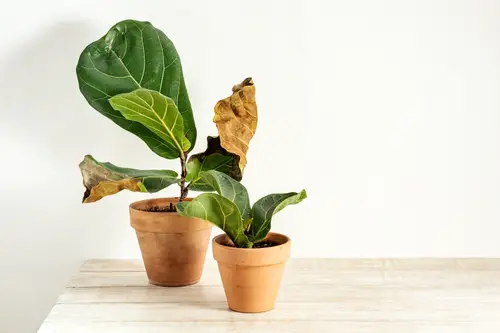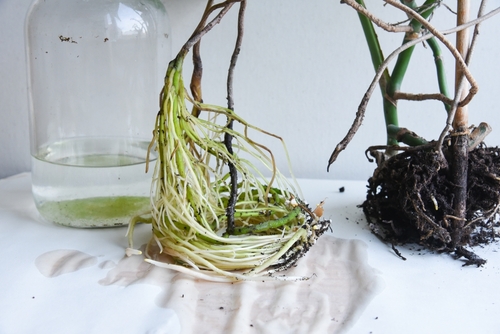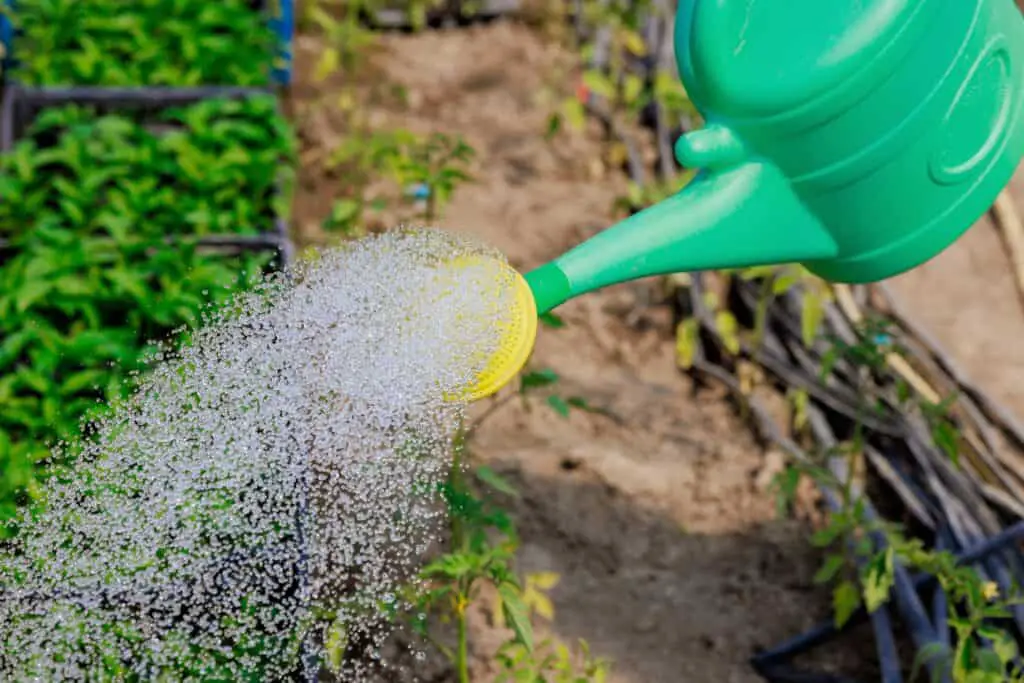Fig trees are a popular fruit tree that can be grown in many different climates. However, one common issue that many fig tree owners face is yellowing leaves.
This can be a frustrating problem, as it can be difficult to determine the cause and find a solution. In this article, we will explore the causes of yellowing leaves on fig trees and provide tips for preventing and treating this issue.
Understanding why fig tree leaves turn yellow is the first step in addressing this problem. While yellowing leaves can be a symptom of a range of issues, the most common causes include overwatering, underwatering, nutrient deficiencies, and pests.
By examining the leaves and other symptoms, it is possible to determine the underlying cause and take steps to address it.
In this article, we will provide a detailed analysis of the causes of yellowing leaves on fig trees, as well as tips for caring for and maintaining your tree to prevent this issue from occurring in the first place.
Whether you are a seasoned fig tree owner or are just starting out, this article will provide valuable information and insights to help you keep your tree healthy and thriving.
Key Takeaways on Fig Tree Leaves Turning Yellow and Falling Off
- Yellowing leaves on fig trees can be caused by a range of issues, including overwatering, underwatering, nutrient deficiencies, and pests.
- By examining the leaves and other symptoms, it is possible to determine the underlying cause of yellowing leaves and take steps to address it.
- Proper care and maintenance of your fig tree can help prevent yellowing leaves and keep your tree healthy and productive.
Check out these other related posts:
- Weed Leaves Turning Yellow with Brown Spots
- Watermelon Plant Leaves Turning Yellow
- Wandering Jew Leaves Turning Yellow
Understanding Fig Tree Leaves Turning Yellow

When a fig tree’s leaves turn yellow and fall off, it can be a sign of stress or a problem with the tree’s health. Here are some possible reasons why fig tree leaves turn yellow:
1. Seasonal Changes
Like other deciduous trees, fig trees normally drop their leaves in the fall. Since maintaining leaves and keeping them alive during winter takes much more energy than regrowing them in the spring, deciduous trees would rather drop them.
Leaves commonly turn yellow before being shed. If the yellowing of the leaves occurs during the fall season, it is most likely a natural process.
2. Watering Issues
Watering issues are one of the most common reasons for fig tree leaves turning yellow. Overwatering or underwatering can cause stress to the tree, leading to yellow leaves.
If the soil is too wet, the roots can become suffocated and start to rot, leading to yellow leaves. On the other hand, if the soil is too dry, the tree may not be able to absorb enough water, leading to yellow leaves.
3. Nutrient Deficiencies
If a fig tree is not getting enough nutrients, it can lead to yellow leaves. Nitrogen, phosphorus, and potassium are essential nutrients for plant growth, and a lack of any of these nutrients can cause yellowing of the leaves. A soil test can help determine if the tree is lacking in any specific nutrient.
4. Pest Problems

Pests like spider mites, scale insects, and whiteflies can cause yellowing of the leaves. These pests feed on the sap of the tree, which can cause damage to the leaves. Inspect the tree for any signs of pest infestation, such as webbing or sticky residue on the leaves.
5. Diseases
Diseases like root rot and fungal infections can cause yellowing of the leaves. These diseases can be caused by overwatering or poor drainage. Inspect the tree for any signs of disease, such as black spots on the leaves or a foul odor coming from the soil.
Fig Tree Leaves Turning Yellow and Falling Off
Fig trees are known for their lush green leaves, but sometimes they can turn yellow and fall off. This can be a sign of stress or disease, and it’s important to identify the cause in order to take appropriate action. Here are some common causes of yellowing leaves on fig trees:
1. Nutrient Deficiencies
A lack of nutrients can cause yellowing leaves on fig trees. This can happen if the tree is not getting enough of a certain nutrient, such as nitrogen, phosphorus, or potassium.
Symptoms of nutrient deficiencies can vary depending on the nutrient, but yellowing leaves are a common sign. To prevent nutrient deficiencies, it’s important to fertilize the tree regularly with a balanced fertilizer.
2. Overwatering and Root Rot

Overwatering can cause the roots of fig trees to rot, which can lead to yellowing leaves. When the roots are damaged, they can’t absorb nutrients and water properly, which can cause the leaves to turn yellow and fall off.
To prevent overwatering and root rot, make sure the tree is planted in well-draining soil and avoid watering too frequently.
3. Pests and Diseases
Pests and diseases can also cause yellowing leaves on fig trees. Common pests that can affect fig trees include spider mites, scale insects, and mealybugs. These pests can suck the sap from the leaves, which can cause them to turn yellow and fall off.
Diseases such as fig rust and leaf spot can also cause yellowing leaves. To prevent pests and diseases, it’s important to keep the tree healthy and well-maintained.
4. Environmental Stress
Environmental stress can also cause yellowing leaves on fig trees. This can happen if the tree is exposed to extreme temperatures, drought, or other environmental factors.
For example, if the tree is exposed to high temperatures or low humidity, it may start to lose leaves. To prevent environmental stress, it’s important to plant the tree in a suitable location and provide it with proper care and maintenance.
Detailed Analysis of Causes
Impact of Nutrient Deficiencies
Yellowing of fig tree leaves can be a sign of nutrient deficiencies. Nitrogen, phosphorus, and potassium are essential nutrients for fig trees. Lack of these nutrients can cause yellowing of leaves. Inadequate nitrogen can cause leaves to turn yellow from the tips, while insufficient potassium can cause yellowing from the edges.
Effects of Overwatering

Overwatering can also cause yellowing of fig tree leaves. When roots are overwatered, they can’t absorb oxygen, which can lead to root rot. This can cause yellowing of leaves, as well as wilting and dropping of leaves.
Common Pests and Diseases
Several pests and diseases can cause yellowing of fig tree leaves. Fig rust is a fungal disease that can cause yellowing and dropping of leaves. Aphids, bugs, and mites can also cause yellowing of leaves by sucking the sap from the tree. Other diseases like leaf blight and botrytis can also cause yellowing of leaves.
Environmental Factors
Environmental factors like temperature, light, and soil pH can also cause yellowing of fig tree leaves. High temperatures, low light, and alkaline soil can lead to yellowing of leaves. Additionally, stress caused by transplanting or fluctuations in temperature can also cause yellowing of leaves.
To prevent yellowing of fig tree leaves, it is important to identify the cause of the problem. Proper watering, fertilization, and pest control can help prevent yellowing of leaves. It is also important to maintain optimal growing conditions by providing adequate light, temperature, and soil pH.
Fig Tree Care and Maintenance
1. Proper Watering
Fig trees require consistent watering to maintain their health and prevent yellowing of leaves. Overwatering can cause root rot, while underwatering can cause stress and leaf drop.
The frequency of watering depends on the climate and soil type. In general, fig trees need watering once a week during the growing season and once every two weeks during the dormant season. Water deeply, making sure the soil is moist to a depth of at least six inches.
2. Nutrient Management

Proper nutrient management is essential for fig trees to thrive. A lack of nutrients can cause yellowing of leaves and poor fruit production. Fertilize your fig tree with a balanced fertilizer once a month during the growing season. Use a fertilizer with an N-P-K ratio of 8-8-8 or 10-10-10. Do not fertilize during the dormant season.
3. Pest Control
Pests can cause significant damage to fig trees, leading to yellowing of leaves and poor fruit production. Common pests that affect fig trees include spider mites, fig beetles, and scale insects. Use insecticidal soap or neem oil to control pests. Regularly inspect your fig tree for signs of pest infestation.
4. Managing Environmental Stress
Environmental stress can cause yellowing of leaves and leaf drop in fig trees. Stress factors include extreme temperatures, drought, and transplant shock. To prevent stress, plant your fig tree in well-draining soil and provide it with adequate water and nutrients.
Protect your fig tree from extreme temperatures by providing shade during hot weather and covering it during frost. If your fig tree has been transplanted, give it time to adjust to its new environment.
Preventing Yellowing Leaves
Yellowing leaves on a fig tree can be prevented by taking proper care of the tree. Here are some tips to help prevent yellowing leaves:
1. Water
Make sure your fig tree is receiving the right amount of water. Overwatering or underwatering can cause yellowing leaves. To ensure your fig tree is receiving the right amount of water, check the soil regularly. If the soil is dry, it’s time to water the tree. If the soil is wet, wait a few days before watering again.
2. Nutrients
Fig trees require proper nutrients to grow healthy leaves. Yellowing leaves can be a sign of nutrient deficiency. To prevent this, fertilize your fig tree with a balanced fertilizer that contains nitrogen, phosphorus, and potassium. Fertilize your tree once a month during the growing season.
3. Pests

Pests can cause yellowing leaves on a fig tree. To prevent this, check your tree regularly for signs of pests such as aphids, spider mites, and scale insects. If you find any pests, treat your tree with an insecticide.
4. Stress
Stress can cause yellowing leaves on a fig tree. To prevent this, avoid transplanting your tree during the growing season. Transplant your tree during the dormant season instead. Additionally, avoid pruning your tree during the growing season. Prune your tree during the dormant season instead.
5. Sunlight
Fig trees require sunlight to grow healthy leaves. Make sure your tree is receiving enough sunlight. If your tree is not receiving enough sunlight, consider moving it to a sunnier location.
6. Proper Care
Proper care is essential for preventing yellowing leaves on a fig tree. Make sure to prune your tree regularly to remove dead or diseased branches. Additionally, make sure to remove any fallen leaves or fruit from around the base of the tree. This will help prevent the spread of disease.
Conclusion
Yellowing and falling off of fig tree leaves can be caused by various factors. Some of the most common reasons include overwatering, underwatering, pest infestations, fungal infections, and nutrient deficiencies.
It is important to identify the underlying cause of the problem in order to provide the appropriate treatment. Regular inspection of the tree for any signs of damage or disease is recommended.
Maintaining proper watering practices and providing adequate nutrients can help prevent yellowing of fig tree leaves. Fertilizing the tree with a balanced fertilizer in the early spring can provide the necessary nutrients for healthy growth.
In addition, pruning the tree during the dormant season can help promote new growth and prevent overcrowding of branches. Removing any dead or diseased branches can also help prevent the spread of disease.
By taking proper care of the fig tree and addressing any issues promptly, it is possible to maintain healthy foliage and a bountiful harvest of delicious figs.
Frequently Asked Questions
What causes yellow leaves and falling off in fig trees?
Yellow leaves and falling off in fig trees can be caused by a variety of factors, including inadequate water supply, nutrient deficiency, transplant shock, or pest attack. Fluctuations in temperature and seasonal changes can also cause fig tree leaves to turn yellow and fall off.
How can I prevent my fig tree leaves from turning yellow and falling off?
To prevent your fig tree leaves from turning yellow and falling off, it is important to ensure that your tree is receiving adequate water and nutrients. Avoid overwatering or underwatering your fig tree, and make sure to fertilize it regularly. Proper pruning and pest control can also help to keep your fig tree healthy.
Is it normal for fig tree leaves to turn yellow and fall off?
It is normal for fig tree leaves to turn yellow and fall off during seasonal changes or as a result of transplant shock. However, if your fig tree is consistently losing large numbers of leaves or if the leaves are turning yellow and falling off prematurely, it may be a sign of a more serious problem.
What are some common reasons for fig tree leaves to turn yellow?
Common reasons for fig tree leaves to turn yellow include inadequate water supply, nutrient deficiency, pest attack, and transplant shock. Overwatering or underwatering your fig tree can also cause the leaves to turn yellow and fall off.
Can overwatering cause fig tree leaves to turn yellow and fall off?
Yes, overwatering can cause fig tree leaves to turn yellow and fall off. When a fig tree is overwatered, the roots become waterlogged and cannot absorb the necessary nutrients from the soil. This can lead to nutrient deficiency and cause the leaves to turn yellow and fall off.
How can I treat my fig tree with yellow leaves and falling off?
To treat your fig tree with yellow leaves and falling off, it is important to identify the underlying cause of the problem. If the issue is related to inadequate water supply or nutrient deficiency, adjust your watering and fertilization practices accordingly.
If the problem is due to pest attack, use an appropriate pest control method. Proper pruning can also help to promote healthy growth and prevent further leaf loss.

Hey, I’m Lisa and I’ve been an avid gardener for over 30 years. I love writing, talking and living in the garden! Feel free to connect with me on my socials below

